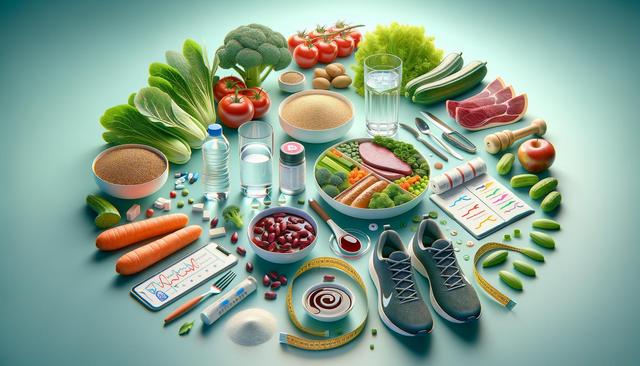Effective Ways to Lower Blood Sugar Quickly and Safely
Lower blood sugar with quick methods like drinking water, exercising, or consuming foods with a low glycemic index. Consuming cinnamon, apple cider vinegar, or foods rich in fiber helps regulate blood sugar and improve insulin sensitivity.

Hydrate to Help Flush Out Excess Sugar
One of the simplest and fastest ways to start lowering your blood sugar is by drinking water. Hydration helps the kidneys flush out excess glucose through urine. When blood sugar levels are high, the body attempts to eliminate the surplus sugar by increasing urination, which can lead to dehydration. Drinking enough water supports this natural detox process and helps regulate blood glucose levels more effectively.
For optimal results, consider these hydration tips:
- Drink a full glass of water as soon as you notice a spike in blood sugar.
- Aim for at least 8–10 glasses of water daily, adjusting for body size and activity level.
- Choose plain water instead of sugary drinks, which can worsen blood sugar levels.
Staying hydrated not only supports better glucose balance but also improves overall metabolic function, digestion, and energy. It’s a simple habit that can make a significant difference in both the short and long term.
Move Your Body with Light Physical Activity
Exercise is a powerful tool in managing blood sugar levels. Even a short walk after meals can reduce glucose concentration in the bloodstream by helping muscles absorb sugar for energy. Physical activity does not have to be intense; consistency and timing are more important than intensity when it comes to glucose control.
Here are a few effective activities to try:
- Walking briskly for 15–30 minutes
- Light cycling or stationary biking
- Gentle yoga or stretching routines
- Bodyweight exercises like squats and lunges
These forms of exercise enhance insulin sensitivity and encourage glucose uptake by muscle cells. For people managing fluctuating sugar levels, it’s important to monitor how your body responds to movement and adjust activity accordingly. Always consult a healthcare provider if you’re starting a new exercise routine, especially if you have complications related to blood sugar management.
Choose Low Glycemic Index Foods
Foods with a low glycemic index (GI) are digested and absorbed more slowly, leading to a gradual rise in blood sugar instead of a sudden spike. Including these foods in your meals can help stabilize glucose levels throughout the day. They also tend to be rich in fiber, which supports digestion and further moderates sugar absorption.
Examples of low GI foods include:
- Leafy greens and cruciferous vegetables
- Legumes such as lentils and chickpeas
- Whole grains like quinoa and barley
- Sweet potatoes and yams
- Berries and apples
Pairing carbohydrates with proteins or healthy fats can also help reduce the overall glycemic impact of a meal. For instance, enjoying an apple with a handful of nuts or whole-grain toast with avocado may support better glucose control. Planning meals with a focus on balanced macros and low-GI ingredients can be a proactive approach to managing sugar spikes.
Utilize Natural Supplements Mindfully
Several natural ingredients have shown potential in supporting healthy blood sugar levels. While they are not substitutes for medical treatment, they can complement a healthy lifestyle when used appropriately. Among these, cinnamon and apple cider vinegar are two widely researched options known for their ability to improve insulin sensitivity and glucose metabolism.
How to incorporate them:
- Cinnamon: Add a sprinkle to oatmeal, smoothies, or herbal tea. Ceylon cinnamon is often preferred for its lower coumarin content.
- Apple cider vinegar: Mix 1–2 teaspoons in a glass of water before meals to help reduce post-meal glucose spikes.
Other supplements like chromium, magnesium, and berberine have also been linked to improved blood sugar control. However, it’s essential to consult with a healthcare provider before starting any supplement, as interactions with medications or underlying health conditions may occur. Responsible use of natural aids can offer additional support in a comprehensive blood sugar management plan.
Boost Fiber Intake for Long-Term Balance
Fiber plays a crucial role in slowing the absorption of sugar into the bloodstream, helping to prevent rapid spikes and crashes. Soluble fiber in particular forms a gel-like substance in the gut that slows digestion and supports stable blood sugar levels. Consuming fiber-rich foods consistently can also improve cholesterol levels, support satiety, and aid in weight management—all of which are beneficial for glucose control.
High-fiber foods to include:
- Oats and barley
- Chia seeds and flaxseeds
- Beans and lentils
- Vegetables like broccoli, carrots, and Brussels sprouts
- Fruits such as pears, oranges, and berries
Gradually increasing fiber intake is recommended to avoid digestive discomfort. Drinking enough water is also important when adding more fiber to your diet, as it helps move fiber through the digestive system smoothly. A high-fiber eating pattern not only supports immediate glucose control but also contributes to long-term metabolic health and disease prevention.
Conclusion: Making Smart, Sustainable Choices
Managing blood sugar levels quickly and effectively involves a combination of simple actions and consistent habits. From staying hydrated and incorporating light physical activity to choosing low glycemic index foods and using natural supplements wisely, each strategy contributes to better glucose control. Adding more fiber to your diet further enhances the body’s ability to maintain stable sugar levels throughout the day.
While these methods can offer immediate support, it’s important to view them as part of a broader, long-term approach to health. Regular monitoring, personalized nutrition, and collaboration with healthcare professionals ensure that short-term strategies lead to sustainable wellness. For those aiming to improve metabolic health, these practical steps offer a well-rounded foundation.